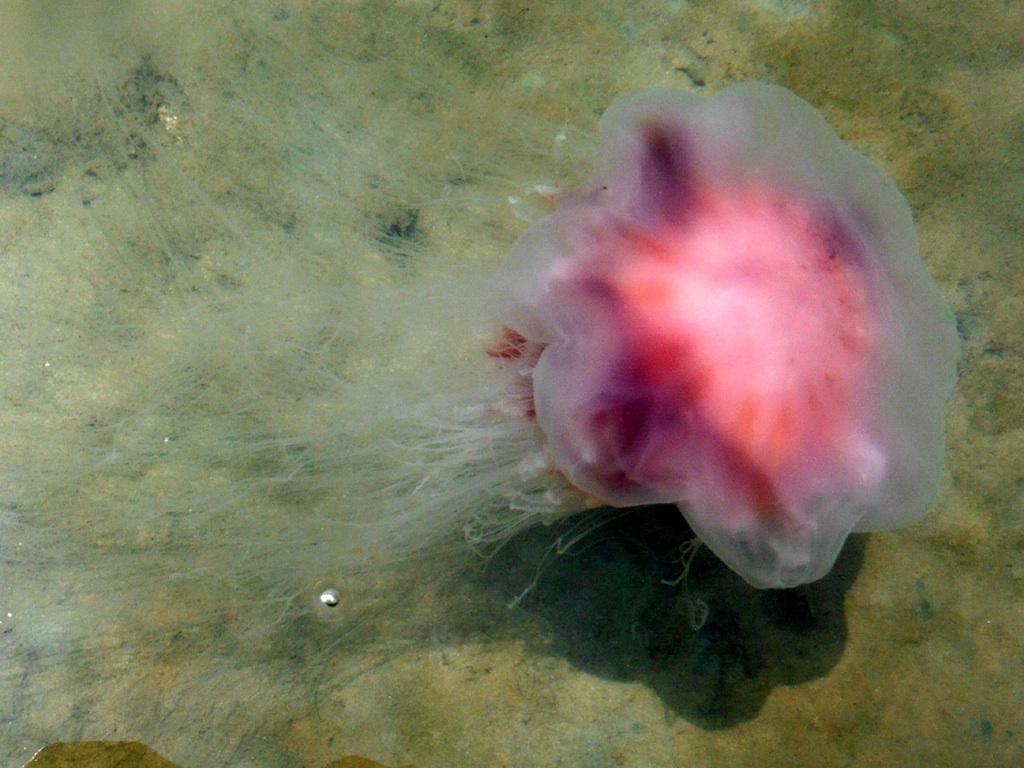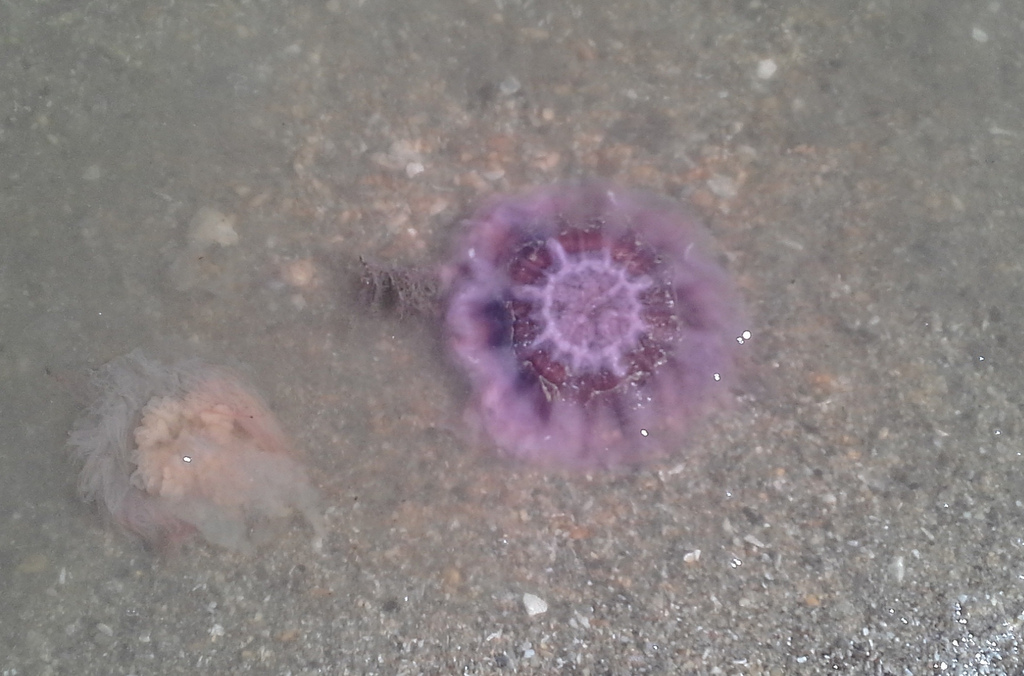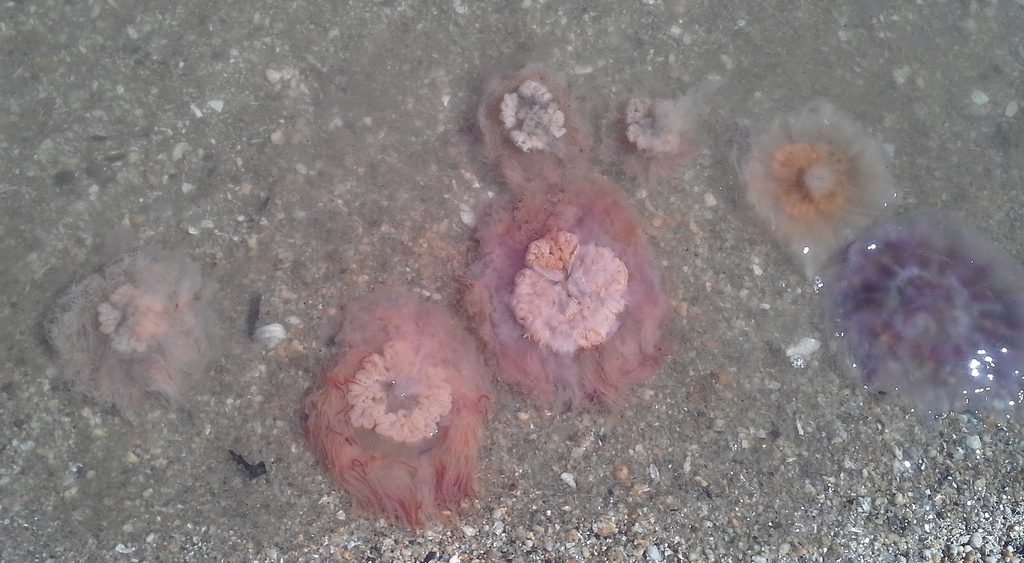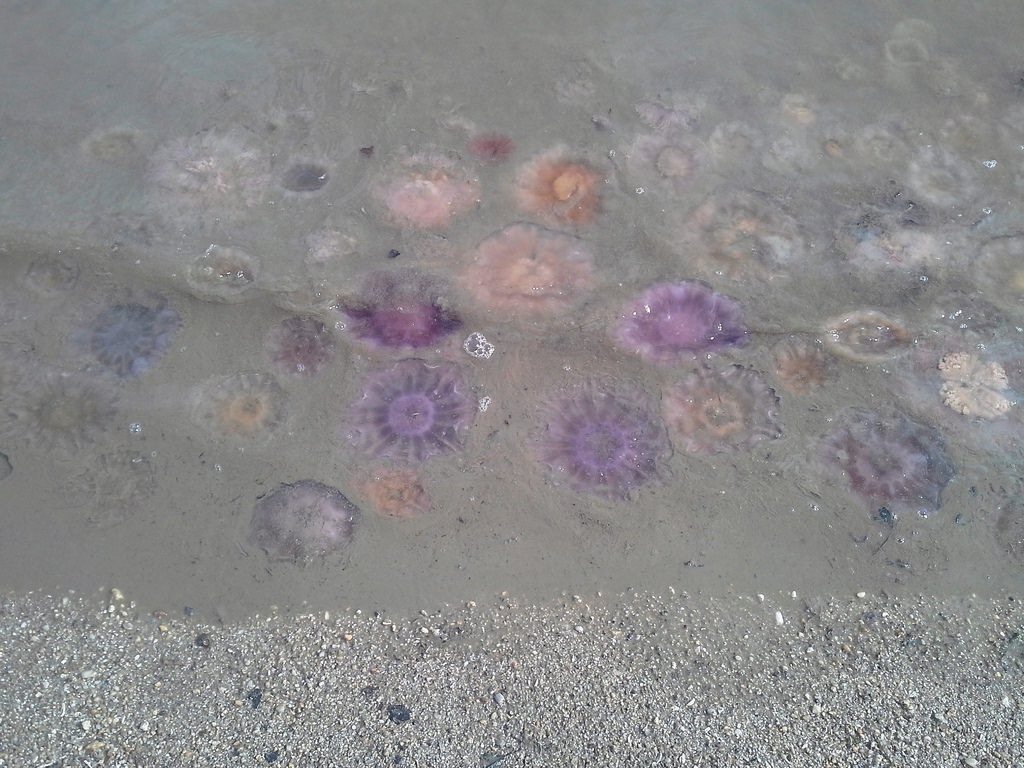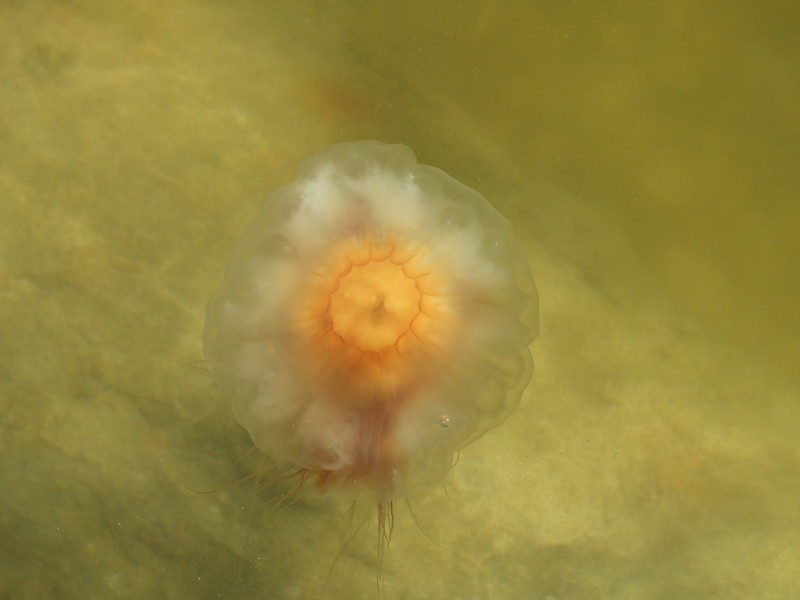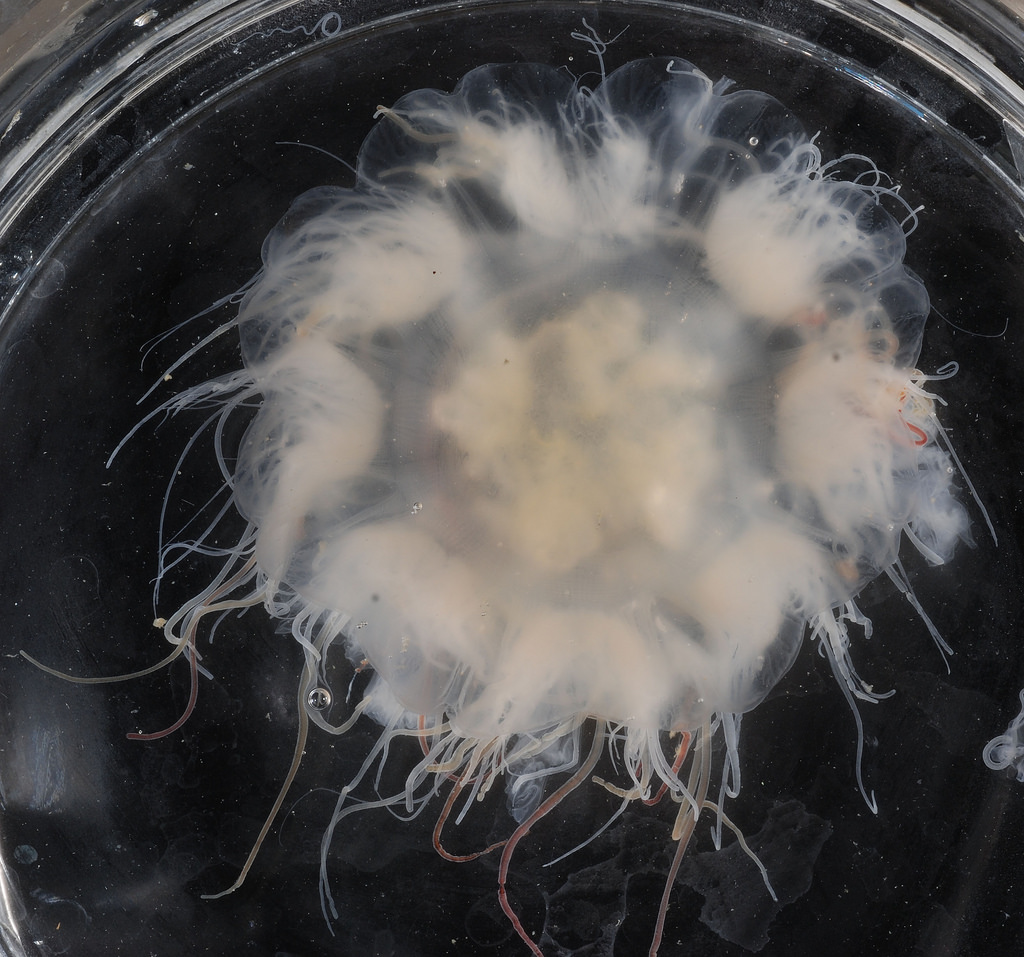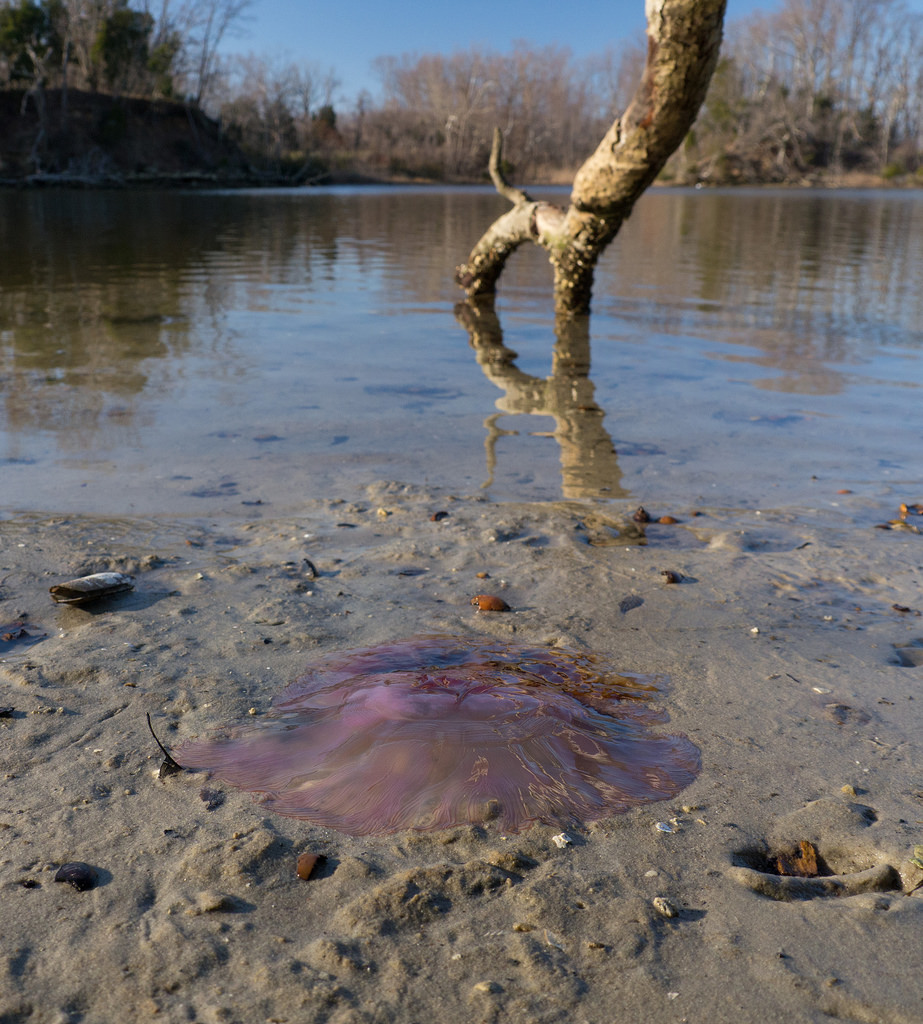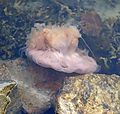Map Snapshot







13 Records
Status
The Lion's-mane Jellyfish is a cold season visitor to Maryland's Coastal Bays and the Chesapeake Bay. It is a northern species that barely reaches the Chesapeake Bay. The Lion's-mane Jellyfish we see here are typically much smaller than the jellyfish that stay further north. This is the largest jellyfish species ever recorded! According to the Chesapeake Bay Program, "Lion’s mane jellyfish that visit the Bay average about four to six inches in diameter, similar in size to the sea nettle. Travel further north, however, and you may encounter a much larger specimen. In 1870, the largest recorded lion’s mane jellyfish washed up along a beach in Massachusetts: its body measured more than seven feet in diameter, and its tentacles were 120 feet long."
Description
It can be easily separated from other jellyfish by the bright colors of the inner bell. It's also the only jellyfish in our region that you are likely to observe in winter and early spring. Note distinctive structure and eight clusters of tentacles.
Seasonality Snapshot
Source: Wikipedia
| Lion's mane jellyfish | |
|---|---|

| |
| In Gullmarn fjord at Sämstad, Lysekil Municipality, Sweden | |
| Scientific classification | |
| Domain: | Eukaryota |
| Kingdom: | Animalia |
| Phylum: | Cnidaria |
| Class: | Scyphozoa |
| Order: | Semaeostomeae |
| Family: | Cyaneidae |
| Genus: | Cyanea |
| Species: | C. capillata
|
| Binomial name | |
| Cyanea capillata | |
| Synonyms[1] | |
| |
The lion's mane jellyfish (Cyanea capillata) is one of the largest known species of jellyfish. Its range is confined to cold, boreal waters of the Arctic, northern Atlantic, and northern Pacific Oceans. It is common in the English Channel, Irish Sea, North Sea, and in western Scandinavian waters south to Kattegat and Øresund. It may also drift into the southwestern part of the Baltic Sea (where it cannot breed due to the low salinity). Similar jellyfish – which may be the same species – are known to inhabit seas near Australia and New Zealand. The largest recorded specimen was measured off the coast of Massachusetts in 1865 and had a bell with a diameter of 210 centimetres (7 feet) and tentacles around 36.6 m (120 ft) long.[2] Lion's mane jellyfish have been observed below 42°N latitude for some time in the larger bays of the East Coast of the United States.
Name
[edit]The lion's mane jellyfish is also known as the arctic red jellyfish,[3] hair jelly,[4] snottie,[5] sea blubber[6] or giant jellyfish.[citation needed]
Taxonomy
[edit]The taxonomy of the Cyanea species is not fully agreed upon; some zoologists have suggested that all species within the genus should be treated as one. Two distinct taxa, however, occur together in at least the eastern North Atlantic, with the blue jellyfish (Cyanea lamarckii Péron & Lesueur, 1810) differing in color (blue, not red) and smaller size (10–20 cm [3+7⁄8–7+7⁄8 inches] diameter, rarely 35 cm [14 inches]). Populations in the western Pacific around Japan are sometimes distinguished as Cyanea nozakii, or as a subspecies, C. c. nozakii. In 2015, Russian researchers announced a possible sister species, Cyanea tzetlinii found in the White Sea.[7]
Description
[edit]Lion's mane jellyfish (Cyanea capillata) are named for their showy, trailing tentacles reminiscent of a lion's mane. They can vary greatly in size: although capable of attaining a bell diameter of over 2 m (6 ft 7 in), those found in lower latitudes are normally smaller than their far northern counterparts, with a bell about 50 cm (20 in) in diameter. Furthermore, larger specimens are typically further offshore than smaller ones. Juveniles are lighter orange or tan, very young lion's manes are occasionally colorless and adults are red and start to darken as they age.
While most jellyfish have a circular bell, the bell of the Lion's Mane is divided into eight lobes, giving it the look of an eight-point star. Each lobe contains about 70 to 150 tentacles,[8][9] arranged in four fairly distinct rows. Along the bell margin is a balance organ at each of the eight indentations between the lobes – the rhopalium – which helps the jellyfish orient itself. From the central mouth extend broad frilly oral arms with many stinging cells called Cnidocytes.[10] Closer to its mouth, its total number of tentacles is around 1,200.[11]
The long, thin tentacles which emanate from the bell's subumbrella have been characterised as "extremely sticky"; they also have stinging cells. The tentacles of larger specimens may trail as long as 30 m (100 ft) or more, with the tentacles of the longest known specimen measured at 36.6 m (120 ft) in length, although it has been suggested that this specimen may actually have belonged to a different Cyanea species.[12] This unusual length – longer than a blue whale – has earned it the status of one of the longest known animals in the world.[13]
Behavior and reproduction
[edit]
Lion's mane jellyfish remain mostly very near the surface, at no more than 20 m (66 ft) depth. Their slow pulsations weakly drive them forward, so they depend on ocean currents to travel great distances. The jellyfish are most often spotted during the late summer and autumn, when they have grown to a large size and the currents begin to sweep them to shore. Unlike most pelagic jellyfish, they are completely solitary and rarely travel in groups.
The lion's mane jellyfish uses its stinging tentacles to capture, pull in, and eat prey such as fish, zooplankton, sea creatures, and smaller jellyfish.[14]
Like other jellyfish, lion's manes are capable of both sexual reproduction in the medusa stage and asexual reproduction in the polyp stage.[15] Lion's mane jellyfish have four different stages in their year-long lifespan: a larval stage, a polyp stage, an ephyrae stage, and the medusa stage.[15] The female jellyfish carries its fertilized eggs in a tentacle, where the eggs grow into larvae. When the larvae are old enough, the female deposits them on a hard surface, where the larvae soon grow into polyps. The polyps begin to reproduce asexually, creating stacks of small, immature medusae called ephyrae.[16] The individual ephyrae break off from the stacks, where they eventually grow into the mature medusa stage to become full-grown jellyfish.[17]
Sting and human contact
[edit]
Human encounters with the jellyfish can cause temporary pain and localized redness.[18] In normal circumstances, however, and in healthy individuals, the stings of the jellyfish are not known to be fatal; vinegar can be used to deactivate the nematocysts. If there is contact with a large number of tentacles, however, medical attention is recommended after exposure.
There may be a significant difference between touching a few tentacles with fingertips at a beach and accidentally swimming into the jellyfish. The initial sensation is more strange than painful and feels like swimming into warmer and somewhat effervescent water. Some minor pain will soon follow.[citation needed] Normally, there is no real danger to humans (with the exception of people suffering from special allergies), but in cases when someone has been stung over large parts of their body by not just the longest tentacles but the entire jellyfish (including the inner tentacles, of which there are around 1,200[11]), medical attention is recommended as systemic effects can be present.[19] Although rare, severe stings in deep water can also cause panic followed by drowning.[20][11]
In July 2010, around 150 beachgoers were stung by the remains of a broken-up lion's mane jellyfish along Wallis Sands State Beach in Rye, New Hampshire, US. Considering the size of the species, it is believed that this incident was caused by a single specimen.[21]
In popular culture
[edit]A photograph widely distributed on the internet appears to show an anomalously large lion's mane dwarfing a nearby diver. The photo was subsequently shown to be a hoax.[22]
On the television program QI, the show claimed that the longest animal in the world was the lion's mane jellyfish. This was later corrected – in 1864, a bootlace worm (Lineus longissimus) was found washed up on the coast of Fife, Great Britain, that was 55 m (180 feet) long. However, this claim is disputed, as bootlace worms can easily stretch to several times their natural length, so it is possible the worm did not actually grow to be that length. If that is the case, the lion's mane jellyfish would indeed be the longest animal in the world.[23]
The creature is referred to as the culprit in the 1926 short story "The Adventure of the Lion's Mane" in The Case-Book of Sherlock Holmes by Sir Arthur Conan Doyle.[24]
Predators
[edit]Seabirds, larger fish such as ocean sunfish, other jellyfish species, and most sea turtles will only attack juveniles or smaller specimens while a fully grown adult is incapable of being eaten, due to their massive size and the abundance of stinging tentacles they possess, although both adults and juveniles have been documented eaten by anemones.[15] The leatherback sea turtle feeds almost exclusively on them in large quantities during the summer season around Eastern Canada.[25]
Gallery
[edit]-
Lion's mane jellyfish capturing three moon jellyfishes
-
Lion's mane jellyfish with full threads visible
-
Lion's mane jellyfish contracted
-
Lion's mane jellyfish expanding into star formation
-
Lion's mane jellyfish open, showing underside
-
Life-sized model in the Smithsonian Museum of Natural History, Washington DC, US
-
Small, dead lion's mane jelly washing up on the beach
References
[edit]- ^ Collins, A.G.; Morandini, A.C. (2023). World List of Scyphozoa. Cyanea capillata (Linnaeus, 1758). Accessed through WoRMS on 2023-05-31
- ^ Agassiz, Alexander. Illustrated Catalogue of the Museum of Comparative Zoology: North American Acalephae. Vol. 2. p. 44.
- ^ "Wildlife Safety: Jellyfish". Parks Canada. 13 December 2023. Retrieved 5 September 2024.
- ^ "Hair jelly (Cyanea capillata)". Australian Venom Research Unit. Archived from the original on 19 April 2013.
- ^ "Snottie (Cyanea s.)". Beachsafe. Retrieved 5 September 2024.
- ^ "Sea Blubber | Reef Environmental Education Foundation".
- ^ Glafira D. Kolbasova; Arthur O. Zalevsky; Azamat R. Gafurov; Philipp O. Gusev; Margarita A. Ezhova; Anna A. Zheludkevich; Olga P. Konovalova; Ksenia N. Kosobokova; Nikita U. Kotlov; Natalia O. Lanina; Anna S. Lapashina; Dmitry O. Medvedev; Katerina S. Nosikova; Ekaterina O. Nuzhdina; Georgii A. Bazykin; Tatyana V. Neretina (2015). "A new species of Cyanea jellyfish sympatric to C. capillata in the White Sea". Polar Biol. 38 (9): 1439–1451. Bibcode:2015PoBio..38.1439K. doi:10.1007/s00300-015-1707-y. S2CID 12405201.
- ^ "Lion's Mane Jellyfish". Scubatravel.co.uk. Archived from the original on 11 January 2014. Retrieved 3 September 2010.
- ^ "Lions Mane Jellyfish – Types Of Jellyfish". 8 January 2011. Archived from the original on 8 January 2011.
- ^ Kozloff, Eugene (2003). Seashore Life of the Northern Pacific Coast. University of Washington Press. pp. 54, 56 (1983 edition). ISBN 978-0295960845.
- ^ a b c "15 Facts About the Lion's Mane Jellyfish". 15 February 2015. Archived from the original on 6 January 2018. Retrieved 6 January 2018.
- ^ McClain, Craig R.; Balk, Meghan A.; Benfield, Mark C.; Branch, Trevor A.; Chen, Catherine; Cosgrove, James; Dove, Alistair D.M.; Gaskins, Lindsay C.; Helm, Rebecca R. (13 January 2015). "Sizing ocean giants: patterns of intraspecific size variation in marine megafauna". PeerJ. 3: e715. doi:10.7717/peerj.715. ISSN 2167-8359. PMC 4304853. PMID 25649000.
- ^ "Lion's Mane Jellyfish – Reference Library". redOrbit. 18 June 2009. Retrieved 18 August 2018.
- ^ "Lion's Mane Jellyfish : Discovery Channel". Dsc.discovery.com. 23 May 2013. Retrieved 8 September 2013.
- ^ a b c "Lions Mane Jellyfish". Types Of Jellyfish. Archived from the original on 8 January 2011. Retrieved 3 September 2010.
- ^ "SCDNR – Jelly fish". Dnr.sc.gov. Archived from the original on 12 November 2008. Retrieved 3 September 2010.
- ^ "Open ocean – Jellyfish life cycle – Te Ara Encyclopedia of New Zealand". Teara.govt.nz. 2 March 2009. Retrieved 3 September 2010.
- ^ "Lion's Mane Jellyfish". Jellyfishfacts.net. Archived from the original on 26 December 2010. Retrieved 3 September 2010.
- ^ Mahon, Andrew; Mallinson, Tom E (2020). "Lion's mane jellyfish sting". International Paramedic Practice. 10 (2): 46–48. doi:10.12968/ippr.2020.10.2.46. ISSN 2052-4889. S2CID 225837493.
- ^ "Jellyfish stings – Symptoms and causes". Mayo Clinic.
- ^ "150 Stung By Jellyfish At Rye Beach – New Hampshire News Story – WMUR Manchester". Wmur.com. 21 July 2010. Archived from the original on 14 October 2011. Retrieved 3 September 2010.
- ^ "Picture of Giant Lion's Mane Jellyfish – Facts – Hoax Or Fact". www.hoaxorfact.com. Archived from the original on 14 October 2017. Retrieved 18 January 2018.
- ^ Carwardine, M. 1995. The Guinness Book of Animal Records. Guinness Publishing. p. 232.
- ^ The Complete Sherlock Homes Short Stories by Sir Arthur Conan Doyle. published by John Murray. 1928, reprinted October 1966, page 1285
- ^ Heaslip, Susan G.; Iverson, Sara J.; Bowen, W. Don; James, Michael C. (2012). "Jellyfish Support High Energy Intake of Leatherback Sea Turtles (Dermochelys coriacea): Video Evidence from Animal-Borne Cameras". PLOS ONE. 7 (3): Article e33259. Bibcode:2012PLoSO...733259H. doi:10.1371/journal.pone.0033259. PMC 3306388. PMID 22438906.
Other sources
[edit]- British Marine Life Study Society – C. capillata and C. lamarcki
- Marine Life Information (UK)
- Marine Biological Laboratory (Massachusetts)
- Pacific Coast jellies
External links
[edit]- Video footage of stranded Lion's Mane Jellyfish
- Photos of Lion's mane jellyfish on Sealife Collection
